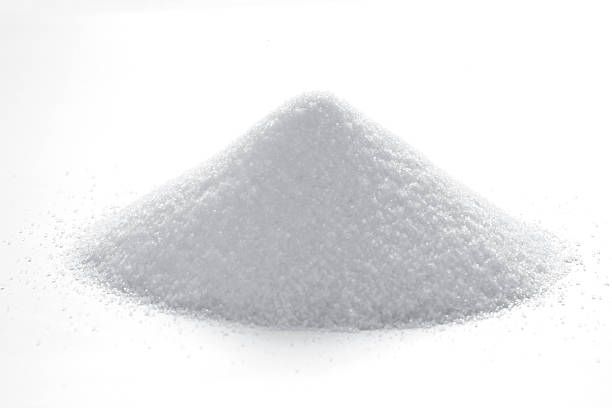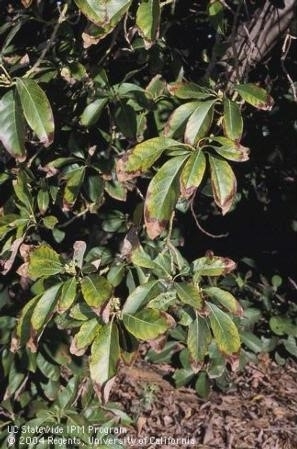Irrigated agriculture must always contend with salts. Five years of drought and its effects can magically disappear, but it will be back again. Low rainfall is the norm for California. We rely on winter rainfall to leach the salts from root zones that have accumulated salts from previous irrigations. Salinity affects plant growth and understanding what it is and how it is measured and evaluated need to be understood. Just having wet soil that is full of salts is not going to help a plant, it's going to add stress and eventually physiological and disease problems - https://ucanr.edu/blogs/Topics/index.cfm?start=28&tagname=disease
All waters, even rain water, have some salts dissolved in them, so all waters could be called saline. The term saline is restricted to waters with concentrations that could cause harm to plants or people. Seawater is highly saline, many wells are moderately saline. But unlike humans that excrete salts, plants are often affected by salt levels that have very little health impact on humans. Well waters used for irrigation can often exceed standards for plants that are fit for human consumption. However, with proper management many waters can be used on plants, depending on the plant species. Domestic water supplies from cities typically have better quality than some well waters because they are monitored and often blended to meet human consumption. Most domestic water supplies have low concentrations of salts and are not considered to be saline. However, using even domestic water in growing subtropicals does not mean that we should not be concerned about salinity.
Before going any further it is worth remembering that salt is not just the sodium chloride that's on the table. Salts are combinations of electrically charged ions. These ions separate from one another when a salt dissolves in water. Water with dissolved sodium chloride and potassium nitrate contains sodium, potassium, chloride and nitrate ions. The most common ions in natural waters are:
sodium (Na+) chloride(Cl-) sulfate (SO42-)
calcium (Ca+) boron (H3BO3)
magnesium (Mg+) bicarbonate (HCO3-)
Different waters can have very different proportions of these ions and these proportions can change with time. Some typical analyses of City of San Buenaventura water can be seen in the following chart (2015 Annual Report of the City of San Buenaventura).
Ionic composition of some wells in Ventura
|
Sample |
Na+ |
Ca+ |
Mg+ |
Cl- |
SO42- |
TDS |
EC |
|
|
|
|
(mg/l) |
|
|
|
(umhos/cm) |
|
1 |
200 |
259 |
70 |
92 |
839 |
1668 |
1990 |
|
2 |
45 |
92 |
191 |
44 |
210 |
645 |
874 |
|
3 |
28 |
59 |
21 |
20 |
140 |
316 |
580 |
Total dissolved solids (TDS) and electrical conductivity (EC) are two different ways of measuring the total amount of salts in water. The old way of taking a specified volume (l for liter) of water and boiling it down to the residue which is weighed (mg for milligram) gives TDS. The more modern technique is to measure the electrical current a water will carry (umhos/cm or micromhos/cm), which is in proportion to the number of ions in the water.
Natural waters also contain low concentrations of many other elements. For most, the amounts are too low to be either harmful or beneficial to plants. The main exception is boron which can be a problem for sensitive plants, such as citrus and avocado and probably for cherimoya as well, when in excess of 1 mg/l. Many well waters in Santa Barbara and Ventura Counties contain potentially harmful levels of boron for plants. This is not as common a problem in San Diego County.
In addition to the ions mentioned, there are also those that come from fertilizers and the soil. The main extra ions are potassium, ammonium, nitrate and phosphate. The concentrations of these will depend on the type of soil and the amounts and kinds of fertilizers applied, minus the amounts taken out by plants, held by the soil and lost by leaching or erosion.
In evaluating a water for its potential to harm plants, it is necessary to look at total salinity, as well as the specific ions. Waters with a TDS in excess of 1000 mg/l or an EC greater than 1500 umhos/cm might pose problems for sensitive subtropical plants, and none at all to tolerant plants like figs, apricots or pomegranates. Waters with an excess of sodium and/or chloride (more than 100 mg/l) can induce symptoms that are similar to high levels of salinity.
In most cases, plants respond by initially having their leaf margins turn yellow and die. This happens first on older leaves because they have had the longest time to accumulate the ions. Annual plants are often less affected than perennials, since they do not grow long enough to accumulate sufficient ions to cause damage.
As trees remove water from the soil, the concentration of salts in the remaining soil water increases. Plants adapt to moderate increases, but if the plant is sensitive (and most subtropicals are), it will slow growth in response. If the salt increase is small, the growth reduction will be small and acceptable. But if the level of fertilizer use is high, the water quality poor, or the soil has not been properly leached, the increased soil salinity could reduce growth seriously.
The effects of salinity are usually gradual on plants, unless too much fertilizer has been suddenly applied or strong, dry winds causes rapid drying. Also, with some domestic water there is variation in concentration and kinds of salts in the water with time. The 200 mg/l of sodium in water sample 1 on the chart would be a problem if this were what the homeowner continuously received. However, according to city data, this house does get 94 mg/l at times (not on the chart). The better quality water serves to flush out the higher concentration salts. And this is how to practically deal with poorer quality water, occasionally leach the soil with a volume of water in excess of plant need. When there are no leaching rains, we need to be more aware of the potential for salt accumulation in the soil. With proper plant selection and water management even extremely saline waters can be used.
Water Terminology
The ions in water are measured as parts per million (ppm) or milligrams per liter (mg/l), terms which are interchangeable. This is like saying a percent, but instead of the ions' weight per 100 weight of water, it is the ions' weight per million weight of water. The ion concentration also can appear as milliequivalents per liter (meq/l). A milliequivalent is the ppm of that ion divided by its atomic weight per charge.
Example: Ca2+ with atomic weight of 40 and a solution concentration of possibly 200 ppm. Ca2+ has two charges per atom, so it has an atomic weight of 20 per charge. 200 ppm divided by 20 = 10 meq of calcium for a liter of water.
Total Dissolved Solids (TDS): measure of total salts in solution in ppm or mg/L
Electrical Conductivity (EC): similar to TDS but analyzed differently.
Units: deciSiemens/meter(dS/m)=millimhos/centimeter (mmhos/cm)=
1000 micromhos/cm (umhos/cm).
Conversion TDS to EC: 640 ppm=1 dS/m=1000 umhos/cm
Hardness: measure of calcium and magnesium in water expressed as ppm CaCO
pH: measure of how acid or base the solution
Alkalinity: measure of the amount of carbonate and bicarbonate controlling the pH, expressed as ppm CaCO3.
Sodium Adsorption Ratio (SAR): describes the relative sodium hazard of water
SAR= (Na)/((Ca+Mg)/2)1/2, all units in meq/l
There is also an Adjusted SAR which considers the carbonate and bicarbonate present, but does not do much better in predicting plant response.
General Irrigation Quality Guidelines
(U.C. Leaflet 2995, 1979)
Measurement No problem Increasing Unsuitable
Effect on plant growth
EC (dS/m) 3
Na+ (SAR) 9
Cl- (ppm) 140 140-350 >350
H3BO3 (ppm) 2
Effect on soil permeability
EC (dS/m) >0.5
SAR 9
1.5 feet of water with EC of 1.6 dS/m adds 10,000 # of salt per acre
WATER NEEDS TO BE APPLIED NOT ONLY FOR THE PLANT NEED,
BUT ALSO TO LEACH THE SALTS

